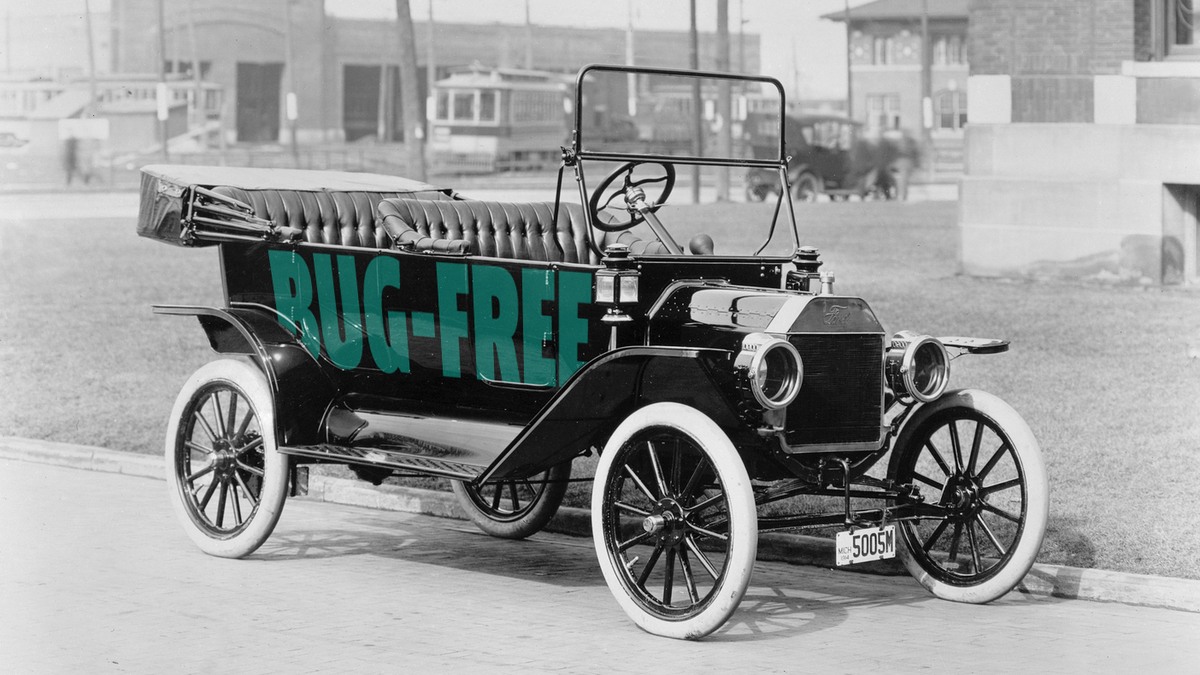An often repeated urban legend about the Ford Model T has been circulating on the internet for a while now, and I am here, predictably, to put a stop to all of the fun. The rumor goes something like this: Henry Ford needed to “recall” some early batches of Model Ts because the penny-pinching industrialist used Spanish Moss to stuff the seats, but did nothing to clean or decontaminate the stuffing, leading to his customers getting bit in the ass by chiggers, no-see-ums, and all sorts of other nasty biting bugs.
The Spanish Moss myth is an entertaining story, one that Google’s useless AI search engine has picked up on as fact, but I’m here to tell you it is often-repeated bunk suitable only for those Facebook-downloaded memes sent by your Me-Maw at 3 a.m. to the family group chat.
I first heard this tale a few years ago and I was pretty surprised. How had I never heard this before! It seems like something that a car history-obsessed kid growing up in the shadow of the Ford Motor Company would know about. I spent many a cold, rainy Michigan weekend absorbing Ford facts from the Henry Ford Museum. I have read many books about Henry Ford—real printed pages researched by folks outside the company—and none recount this tale.
Well, there’s a reason for that. It seems the Spanish Moss stuffing tale is a regional urban legend that started by Southerners and spread to the internet. The earliest instance I can find of this story being recounted online is from a 2003 forum post on Yesterday’s Tractors. The poster cites a tour group operator in Savannah, Georgia, as the source for the information. In fact, I found several sites from the internet’s early days that repeat this myth straight from some Southern tour guide’s mouths, so it seems this legend has had a longer life in the South than online.
I could find nothing in the Detroit Free Press archives housed in the Detroit Public Library about a sudden “recall” or sale-stopage even into the earliest days of the Model T. Nothing in the Detroit society papers (basically gossip rags), nor in the New York Times either. The Ford Motor Company’s gracious archivists turned up diddly squat about Spanish Moss, but plenty of evidence that Ford constructed the seats in even the earliest Model T out of the same materials as carriage seats—horsehair and cotton batting. The archivist did find a letter from a Spanish Moss supplier out of Louisiana urging Ford to consider the fiber for his cars, but no action was ever taken. Even if the letter had led to a change in seat stuffing, it would be Spanish Moss from a Southern supplier who would know to properly dry and cure the moss to rid it of biting insects.
Spanish Moss is a native, perennial epiphytic herb, according to the U.S. Department of Agriculture. It’s also known as that drippy plant that hangs from trees in the American South, making Louisiana swamps look even more spooky and atmospheric than they are already. It’s been used to support human butts since Native American tribes first used it to make a course fabric from the curly inner fibers of the plant, weaving rugs and small cushions from moss. It later served as stuffing in all sorts of furniture but fell out of favor sometime in the 1940s, according to the Los Angeles Times. So while the timing was right for Spanish Moss to be included in the Model T, there is still no evidence this ever happened.
The actual first recall ever issued came just a year after the founding of the National Highway Traffic Safety Administration. Before the Administration, there was no one to force companies to recall vehicles, so the timing makes sense. In 1971, General Motors recalled 6.7 million Chevrolet and GMC vehicles for dangerous engine mount issues.
I am not 100 percent sure where this rumor came from, but I have a theory; Southerners made up the myth as a way to denigrate Ford and his Northern customers. Ford has a surprisingly bad rap down past the mason-dioxin line, and it’s for the best reason; segregationist Southerners have a lot of animosity towards the Big Blue Oval because of the work the Ford Foundation did during the Civil Rights Era.
OK, hold on tight, this is a bumpy and fascinating ride. It all starts with the Fund of the Republic; an organization formed within the Ford Foundation dedicated to protecting free speech and civil liberties during the McCarthyism era.
The Ford Foundation was hugely influential in the ’50s and ’60s, becoming the first nonprofit with a billion-dollar endowment in American history and the wealthiest in the world by the mid-1950s. To be clear, the Foundation and the Ford Motor Company are completely separate entities, but no one has ever blamed racists for being too nuanced in what they hate. The Ford family would eventually part ways with the Foundation in 1976, only returning in 2019 when the Foundation named Henry Ford III (Edsel II’s son) as a trustee.
Neither the left, nor the right really trusted the Ford Foundation. Started by Henry Ford’s son Edsel with an endowment of $25,000 in 1936, right-wingers found the Foundations actions via the fund as un-American (the Fund of the Republic actually faced questioning from the Red-Scare Era Un-American Activities Committee of the House of Representatives) while those on the left found the Foundation undemocratic. One thing was for sure though; supporting Civil Rights was a threat to segregationists in the deep South. A 1956 Time magazine article describes the attitudes of some Southerners towards companies that “support Negro Equality,” and Ford seems to bear the brunt:
In parts of the Deep South, Ford, Falstaff and Philip Morris have been nicknamed “The Three Fs” and made the targets of an extraordinary whispering campaign and economic boycott. The charge: they have aided the cause of Negro equality. But the boycott movement goes far beyond the phonetic Fs and, as practiced by both whites and Negroes, has spread to nearly a score of other companies. Most of the affected companies are reluctant to discuss the subject. Says the general manager of the Coca-Cola bottling plant at Birmingham: “I could tell you a whole lot about it, but I’d just rather not say anything.” Says an official of the Kraft Foods Co. (which was criticized for sponsoring a television showing of Eugene O’Neill’s The Emperor Jones’): “If you start fighting, you just give these idiots a dignity they don’t deserve.”
Most of the boycotts are unorganized, word-of-mouth affairs. Some crop up overnight and wither as swiftly. Others last for weeks or months in the ebb and flow of their effectiveness.
The Knowing Smile. Of all the companies, Ford has probably been the most affected. It is blamed for the civil rights spending of the Fund for the Republic—over which the company has no control.
An Alabama dealer says his sales are off 50%, attributes part of that drop to the boycott. Says he: “If somebody says something about it—even a friend—and you deny it, they just smile at you.” Adds W. M. Turner, a dealer in Selma, Ala.: “The criticism of the whites—and I’m sur prised at some of the intelligent people involved—hurts, and we haven’t got the Negro trade, so you can see how it is.” Ford efforts to combat the criticism have been less than successful. The Memphis assembly plant, for example, began pasting its car windows with stickers, reading: “Built in the South by Mid-Southerners.” One result: the slogan led to such gutter parodies as: “Built in Africa by Apes.”
Oof, that’s some ugly stuff. And it keeps getting uglier. In 1960, an segregationist group called the Members of the Citizens’ Council of Greater New Orleans issued flyers alerting residents not to buy Fords due to the company’s “tax free foundations.” Undeterred, the Ford Foundation only increased funding to organizations like the NAACP as the Civil Rights Movement gained steam. From the Foundation’s website:
Between 1965 and 1970, Ford Foundation grants relating to African-Americans increased from 2.5% of total domestic programmatic outlays to a staggering 40%. This dramatic shift in grant funding coincided with new leadership at the top, but there was also a growing push among Ford’s program staff to support racial justice grantees more overtly.
One such Ford program officer was Christopher Edley, a Harvard-educated lawyer who had served on the U.S. Commission on Civil Rights until 1963, when he joined Ford. He was the foundation’s first African-American program officer. In 1965, with the Civil Rights Act newly on the books, Edley argued that the Ford Foundation had in fact done little to address the country’s racial issues head-on, and that Ford should be doing more to support the implementation of the Act.
Edley began with a hallmark of philanthropic programmatic planning: he surveyed the field of organizations working in this area — identifying potential grantees.
The irony is, of course, that many activist consider the Ford Foundation as engaging in what is known as “Corporate Capture.” Radical Black Power thinkers like scholar Robert L. Allen thought the Foundation was co-opting Black people’s struggles in order to make the movement easier to swallow but ultimately less effective. Indeed, in the 1960s, the NAACP shifted its focus from fighting the horrors of lynching to education reform—one of the Foundation’s number one priorities. The Ford Foundation describes itself as favoring “rational” and “constructive” programs over “the man in the street” needs during this time.
This soup seems, to me, to be perfect for cooking up a myth that allows the entire South to pull one over on the haughty Ford and his son’s meddling, do-gooder Foundation. The myth uniquely combines a lack of common sense about native Southern things on the part of the Northern industrialist with the physical comedy of Ford customers literally getting bitten in the ass by a symbol of the South for the transgression of buying a Ford. It’s exactly the kind of information flotsam repeated by tour guides and on internet forms the world over until it becomes a fun fact, that was never a fact at all.
I guess we’ll never really know where the Ford Model T/Spanish Moss myth came from, but remember: don’t believe everything you read on the internet.







